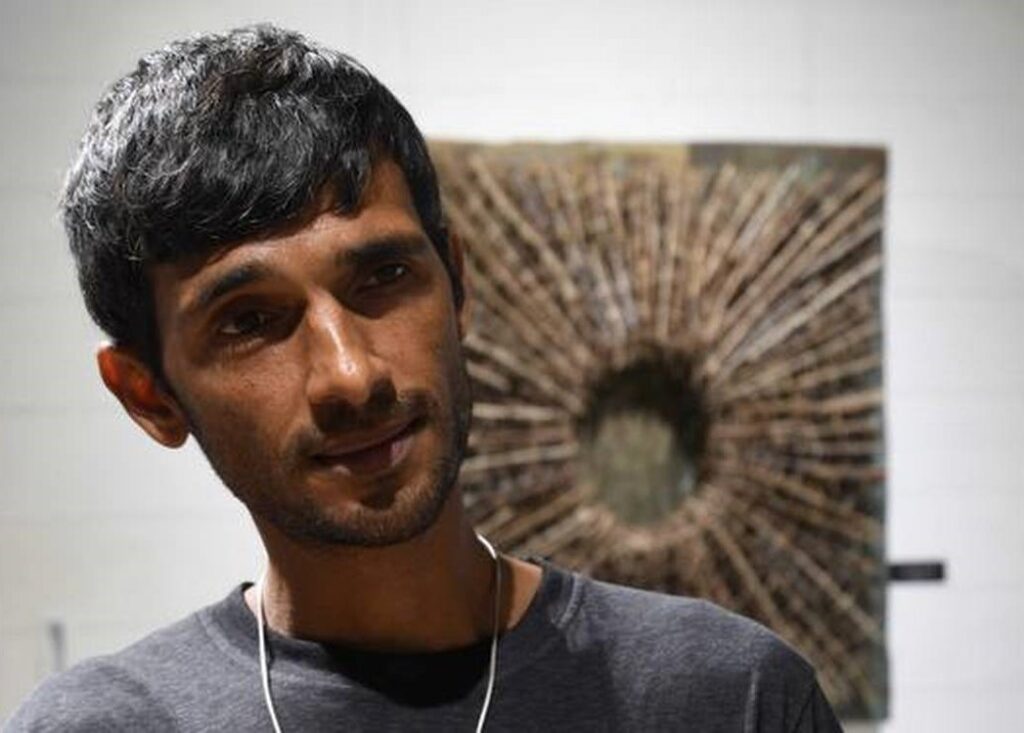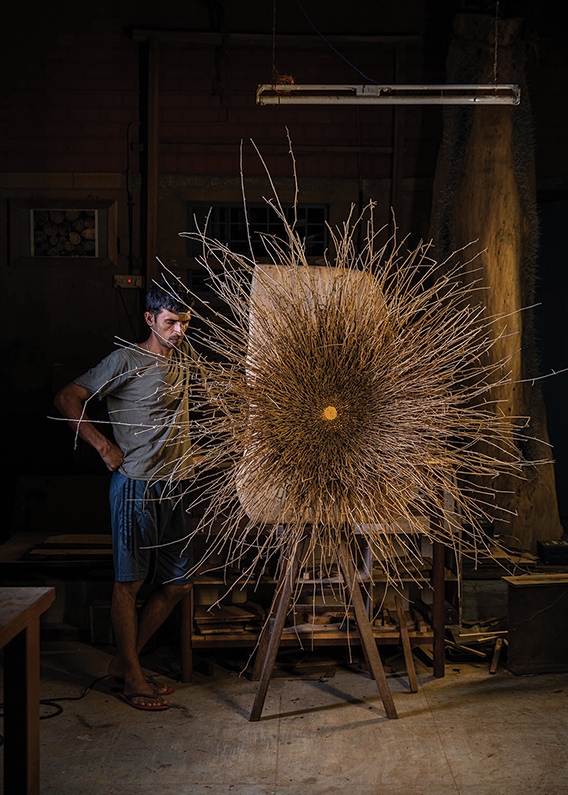
Thorny trails – creations of Sandilya Theuerkauf
Thorns – they define a boundary, limit the access, and create a separation. They are often a detested lot. However, Sandilya Theuerkauf is an exception, and for all the years of his long run as an artist, he has engaged with them deeply; he unfolded their unconventional, raw beauty in his thorny installations, which reassert or reveal their unique identity in nature. Ram Anatharaman Writes
Thorns – they define a boundary, limit the access, and create a separation. They are often a detested lot. No one pays any attention to them until they become a nuisance, an obstruction. And then, the immediate reaction is to pluck them and throw them aside, into the gutters. One could get hurt during the act, and it may bleed or burn as well for a while, but afterwards all that would be erased out of the memory. They are uninvited guests that need to be vacated from the vicinity!
To us humans, thorns may look purposeless. But for the plants, they are instruments of self-defense, creating safe zones with their sharpness in order to protect the plants and trees. In scientific realm, we can approach them as study materials, but beyond that why would anybody be curious enough to look at them more closely? Would anyone willingly spend their time wondering about the aesthetic appeal of those prickly little things? Not likely at all!
However, Sandilya Theuerkauf is an exception, and for all the years of his long run as an artist, he has engaged with them deeply; he unfolded their unconventional, raw beauty in his thorny installations, which reassert or reveal their unique identity in nature. Many years of continuous engagement with nature and rigorous practice in observing one’s environs are the prerequisites for such an endeavor. The outcome of such a longstanding dedication and commitment was on display at the Bangalore International Centre, presented by Kynkyny, the online art gallery for contemporary arts, Bangalore, from the 15th-20th February, 2020. Eighteen large and small stunning pieces of art by Sandilya Theuerkauf composed using wild thorns and wood collected from South India’s scrub forests were exhibited at the artist’s first ever show titled ‘A Trail of Thorns’, which attracted a large number of people from all walks of life. The art pieces were unique in many ways in their conception and presentation, the shock and awe were apparent as many visitors saw something like that for the first time ever! Some were visibly unsettled, and a few others were intrigued and moved!

The pieces were created using different thorns collected from various shrubs and trees such as Bush weed (Flueggea leucopyrus), White thorn tree (Acacia Polyacantha), Calcutta Bamboo (Dendrocalamus strictus) and so on, growing mostly in the arid landscapes in and around the central Deccan region, and a few in the Western Ghats. Sandilya Theuerkauf’s sensorium has been embedded with the sensibility, deep curiosity and childlike wonder that are essential to bring forth the beauty and elegance of such prickly things from the down under to the surface. An overlapping harmony has been created across the borders of the living and non-living, the human and the non-human. And that effort has been devoid of any discrimination between the objects under purview.
Thorns that normally remain obscure in front of our eyes represent many things. In that sense, these artworks are boldly performing an affirmative action of restoring the discarded into the order of things. In a way, the unrepresented are the represented here; the marginalized, suppressed and excluded are re-inscribed into the center of visibility by breaking the hierarchy of aesthetics. The subaltern gains a new dimension as an important piece in the invisible connections. Through an intelligent assemblage of the thorns, Sandilya is attempting to juxtapose and shuffle the traditional spectrum of beauty and horridness, and by breaking the binary he is revealing the hidden poetics of nature, which hitherto have been ignored. While on the one hand these pieces choreograph a dramatic gathering of players intertwined in primordial patterns, on the other hand they also subtly subvert the established aesthetic preferences and priorities in an unpredictable manner. Making use of the language of thorns, Sandilya is mediating the semiotics of space and time, of struggle and resistance, thereby gently leading us into imperceptible arenas of the enigmatic nature. Standing from within, he is unraveling scenes that are totally alien to our daily experiences. Along with that, he is also putting forward the need for reciprocity between humans and nature in a broader perspective, and encouraging an incessant discourse on the interdependence between the two.
A documentary film made by the young filmmaker Manush John that was screened along with the exhibition portrayed the artist and the process of his creation, in which the artist himself explains the story of thorns, his inspirations and philosophy, his inquiries and meditative disclosures. Sandilya spent his childhood in a small remote village in Wayanad, Kerala, amidst the rich rain forests surrounded by hills, streams and wild animals. “Ever since I was a child, I have been making what I think is art. There has always been an inner compulsion to create something in keeping with the life that flourishes around me – creating with mud and sticks, water and stones, feathers and flowers. The process is very physical and my work calls upon my whole body to engage with the land I inhabit. This engagement has been through climbing, walking, swimming, listening, observing and creating using my hands. These, and many others, have been my ways of knowing. This kind of relating to my surroundings is what stays with me, creating memories that hold my body to the places I inhabit.”
Sandilya is presently leading the nature learning program for children in an alternative school called Centre for Learning, near Bangalore. For him, an important part of the creation was the gathering of thorns itself, which involved walking, looking and ‘being’ in places, observing different kinds of plants closely and understanding their tiny details.

Sandilya explains his journey: “It was the observation of the shape and form of one particular thorn that sparked the process of creating these pieces. I was drawn to the thorn’s claw-like shape and character, and slowly I started to notice more and more thorns as well as the plants they protected. I wondered then whether I could make something with these thorns but it took several months for the idea to brew and to become something I could give my time and attention to. The image of many of these thorns together and the texture they would create excited me. I did not imagine at the time that this idea would last beyond a single piece. But observation has its own momentum; an initial look leads to a closer attention which leads you on and on. I began to notice other thorns on trees, climbers and shrubs. This arid landscape where I have walked for years suddenly opened up to me, and its stories were abundant.”
In the words of Manush John, the director of the documentary: “There is a deceptive simplicity to his work and therein lies the intrigue for me. Beyond the familiar geometric patterns made of piercing wood, and beyond the blood spilled to weave these thorns into their inevitable compositions lies an inquiry that continues to engage me. With time and repeated sittings, new worlds begin to manifest on these wooden backings. I see his work as a negotiation between the designs he experiences in nature and the implementation of his own aesthetic explorations. It is unburdened by the aesthetics and preoccupations of time. What he is dealing with is direct first-hand experience, and as the famouse British sculptor Antony Gormley puts it, ‘you can simply sit and attend to the fact of being and discover a philosophical truth’. I feel the work that he does is an acknowledgement of what is around him, and the work becomes an experiment in being faithful to what he sees. When it does come together, it becomes an invitation and portal into the world of tenderness where these thorns speak a language of time, of struggle and purpose.”
On an entirely different plane, these visualizations can be seen as an exposition that is deeply connected with the politics of ecology. These visual representations intricately weave the tales of earth’s protest against the paradigm of modern development and its ways of blind and extremely destructive manipulation of nature. It represents earth’s resistance to the ‘bigger is better’ narrative of globalization and its uni dimensional hegemony propelled by the technological advancements, a curse that has adversely impacted the life systems across territories. The compositions can be deciphered as an invitation to look beyond what is in front of our eyes, past the filters and labels that we put on ourselves or the things and people around us.
It would be appropriate to conclude this piece with the words of the artist himself: “These works I share now are merely a glimpse of what is out there. When you are amidst all that life, you will invariably succumb to it, because it is truly beautiful. And then you, like me, will start seeing our earth as sacred grounds, to be celebrated and protected. Treat these as my humble invitation into the thicket, into a world outside the white cube.”
